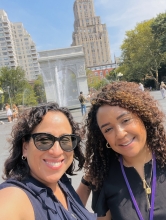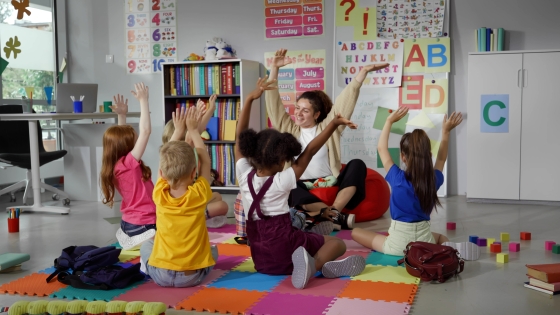Building strong partnerships between families and schools is essential for fostering a consistent and supportive learning environment for students.
Families bring unique experiences and backgrounds to the school community, and when schools implement equitable and inclusive policies that support and welcome families, these partnerships can flourish. Below, we share key strategies for creating a welcoming and collaborative relationship with families, and how to sustain these partnerships throughout the school year.

Maria Garcia, Associate Director, Path Practice and Social Work Support (left), and Janet Rosa, Community Engagement Coordinator (right), lead social work and family engagement initiatives for the Path Program.
Setting the Groundwork: Implementing Equitable and Inclusive School Policies
Just as each student comes to school with their own unique background, families also bring a variety of life experiences. Schools (teachers, administrators, other staff) can build trust with students’ families by implementing policies and procedures that are equitable and inclusive. This involves recognizing and valuing the diverse backgrounds of families and creating a school environment where all feel welcomed and respected. This includes (but is not limited to) alleviating cultural and linguistic mismatch (e.g., translation services, bilingual staff, culturally relevant materials).
Making the First Connection: Intentional and Mindful Interactions
The foundation of any strong partnership begins with the first interaction. At the beginning of the school year, schools should outline clear expectations for family involvement while being mindful of cultural considerations and potential barriers. Here are some practical ways to start:
- Create welcoming spaces: Set up a family corner in the school entrance or classroom with resources and information.
- Reach out to families: Send an email or schedule a phone call with each family.
- Identify common goals: Engage in conversations to learn about each family’s goals, skills, and challenges.
- Understand students’ community and home life: Before offering suggestions to caregivers, ask about their child’s daily experiences to connect home and community life with the curriculum.
Building Communication Systems: Establishing Home-School Communication
Effective two-way communication is key to building and maintaining strong family partnerships. Schools should adopt communication systems that empower caregivers and foster trust. Also, it’s essential to be timely, clear, and solution-focused. Whether through newsletters, pictures, videos, or face-to-face conversations, schools should provide multiple communication options and always lead with positive feedback before discussing challenges. The ACCESS model (below) is an excellent guide for conversations with families:
- Avoid assumptions: Get to know families without making assumptions about their needs or preferences.
- Communication preferences: Ask families how they prefer to communicate (e.g., email, phone, in-person).
- Check documents: Ensure all communications are clear, concise, and free of jargon. Offer translations when needed.
- End with contact information: Always provide a way for families to follow up or ask questions.
- Sensitivity to family context: Be mindful of each family’s unique situation.
- Spotlight the positive: Start communications by highlighting student strengths and progress.

Family events offer a valuable opportunity for connection and meaningful discussions. Path participated in one such event, organized by a Path school in collaboration with FEAST, an international nonprofit, to discuss healthy food choices with school leaders, staff, and parents.
Creating Supported Opportunities: Family-Facing Activities Throughout the Year
Schools can strengthen partnerships by providing ongoing opportunities for families to connect with one another and the school community. Schools should also consider the logistics of family engagement by offering child care, transportation, and food during events, and scheduling activities at convenient times and locations for caregivers. Connecting with families in spaces they already frequent, such as community centers or libraries, can help strengthen relationships. Some ideas include:
- Leverage community programs: Partner with local arts, tutoring, and counseling services to connect families with valuable resources.
- Offer diverse activities: Provide a range of options for family involvement, such as caregiver-led workshops or translation services for school communications.
- Avoid “parenting classes”: Instead, frame activities as opportunities for caregivers to support one another and the school community.
Shifting Power: Engaging Caregivers in Homework
Caregivers play a vital role in supporting their children’s learning at home, especially when it comes to homework. Research shows that caregiver involvement in homework can have a greater positive impact than attendance at school events. By creating structured opportunities for family involvement in homework, schools can help caregivers feel more confident in supporting their children’s learning. Here are a few strategies to engage caregivers in homework:
- Offer flexible activities: Provide choices that fit within different family contexts and resources.
- Emphasize caregiver knowledge: Remind caregivers that they are experts in their child’s life and encourage language-based activities like storytelling and games.
- Set expectations early: Clearly communicate options for how often caregivers can be involved in homework and offer opportunities for feedback.
Sustaining Relationships: Collaboration Throughout the Year
Family partnerships are not a one-time event—they should evolve throughout the school year. Schools should view families as co-educators, acknowledging the unique resources and strengths they bring to the community. Here are a few ways to foster collaboration:
- Expand caregiver roles: Move beyond academic support and encourage families to participate in caregiver support groups, school committees, and teams for school events.
- Clarify caregiver expectations: Let caregivers know they are not expected to teach content but rather to share their child’s experiences with the teacher.
- Organize family events: Host activities such as Family Day, where families can share traditions or create family collages together. Family journals can also be a fun way for caregivers to document their child’s at-home activities and share them with the class.
Building strong family partnerships is a continuous process that requires schools to be intentional, inclusive, and responsive to families' needs. By implementing equitable policies, addressing cultural and linguistic mismatches, and creating opportunities for collaboration and communication, schools can foster a supportive environment where families and educators work together to ensure student success. Strong family-school partnerships are key to creating thriving learning communities, and when families feel valued and heard, students benefit the most.


